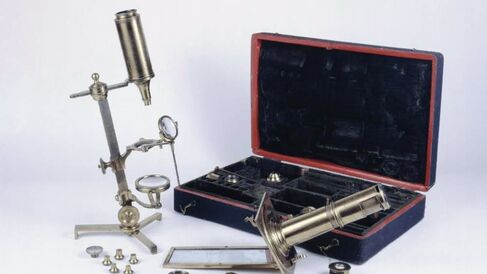A Brief History of the Microscope

The microscope was invented at the end of the 16th century. Its early history is not fully understood, partly because a large number of relevant documents were destroyed during the Second World War. On the other hand, we do know a lot about how the instrument was used, and what people thought of it; this is the kind of information presented in this section.
"For what a better, fitter, gift Could be
in this world's Aged Luciosity?
To help our Blindness so as to devize
a pair of new & Artificial eyes."
Henry Power, In Commendation of ye Microscope, 1661
The predominant calculating aid for nearly three centuries, the slide rule came together gradually as mathematicians used Napier's logarithms in their instruments. Slide rules came in many shapes and sizes, with different rulings suited to their specific application.
With the rise of the slide rule as an essential aid to calculation, a number of inventors began to create rules for specialist applications. With no international standards for their manufacture until the late 19th century, slide rules could be highly idiosyncratic. Rules made for specific purposes could have the support of professional groups, and instrument makers vied for their support by catering to specific needs.
Earliest history
The 17th century saw the microscope put to its first serious use; a number of natural philosophers set about exploring the microscopic world. Henry Power's poem captures the optimism about its potential. After the 1665 publication of Robert Hooke's book Micrographia, and the work of natural philosophers on the continent, the only problem that seemed to stand in the way of the further use of the microscope was the fear that it had shown all that it was possible to see of the microscopic world. From this early period the Whipple Museum has two microscopes, one of them English, the other Italian (Image 1).
The 18th century
In the 1740s a number of books were published that seemed to give the microscope new direction. Before this there was a perceived decline in the use of the instrument. 'Perceived', both then and now, because the relatively high production and use of the microscope did not match the relatively low number of important discoveries. Two optical problems stood in the way of further development: spherical and chromatic aberration.
Rather than concentrate on these problems, the articles here covering the 18th century deal with the ways in which the microscope was manufactured and sold; the way in which it was used in public demonstrations; and the various ways in which the instrument's design was altered to meet the needs of its users. The work of 'natural philosophers', many of whom were fascinated with the microscopic world, provides enormous amounts of historical material, and allows us to try to understand the 18th century on its own terms.
The 19th century
Again, the 19th century saw technical developments that are well represented at the Whipple Museum. Earlier design alterations had made microscope manipulation easier, but now optical improvements that increased the magnification and resolving power of microscopes led to many discoveries. Moreover, the problems of spherical and chromatic aberration were solved before 1830. With the specialisation of science into different disciplines, the microscope found a number of different homes. Biology, palaeontology (the stody of fossils), medicine, geology, and host of other subjects all included the use of the microscope, though usually through the work of only a handful of 'microscopists'.
Aside from one of the first achromatically and spherically corrected microscopes ever made, the Whipple has several microscopes with interesting associations: Charles Darwin's large compound microscope, Giovanni Battista Amici's reflecting microscope, and some pieces associated with John Stevens Henslow are the highlights here. In each case we can take the microscope and its history as a way of understanding the scientists who used it, allowing us to see them at work, and engaged in the practice of science.
The 20th century
Of all the periods in the history of the microscope this is the least researched. There is certainly a huge amount of material that is not yet properly understood, either in terms of its importance or its place in the history of modern science (Image 2). The museum has a number of recent microscopes.
